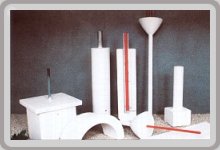Refractory monoliths
Refractory monoliths are produced on the base of calcinated fireclays, high-alumina refractory grogs, andalusite, bauxite, fused corundum, tabular alumina, spinel and high-alumina cements. Advanced technology is applied for monoliths manufacturing. All the processes such as mixture preparation, vibration and drying are automated and computer controlled. Refractory monoliths are used especially in metallurgical plants as well as in variety of industrial branches, where application of refractory materials is demanded, such as monolithic lances for powder additives and gases blowing into the steel bath, as refractory plugs for slag-free tapping from oxygen converter, as tundish dams, as ladle and tundish lids, snorkel for chemical heating of steel etc.

Basic kinds of refractory monoliths:
| TRICAST | Chem. composition | Bulk density | Permanent linear change | Cold crusing strenght | Application temperature | Grain size | Main raw base | |||
|---|---|---|---|---|---|---|---|---|---|---|
| Signature | Al2O3(%) | Fe2O3(%) | CaO (%) | 1100-C (g*cm–³) | (%/0C) | 1100C (MPa) | (MPa/°C) | (°C) | (mm) | |
| BH35L | 35,0 | 4,1 | 10,0 | 2,10 | 1,0/1300 | 40 | 20/1300 | 1300 | 0 – 6,0 | Fireclay |
| BH45L | 45,0 | 1,9 | 7,5 | 2,20 | 1,8/1400 | 30 | 30/1400 | 1400 | 0 – 6,0 | Fireclay |
| BN50LA | 50,0 | 1,2 | 2,7 | 2,30 | 0,1/1450 | 40 | 60/1650 | 1450 | 0 – 5,0 | Fireclay |
| BN82B (BN82B3) | 80,0 | 1,5 | 1,8 | 2,80 | -1,0/1550 | 70 | 100/1550 | 1550 |
0 – 6,0 |
Bauxite |
| BNS95TS | 92,0 | 0,2 | 1,3 | 3,00 |
-1,8/1750 |
30 | 100/1750 | 1700 | 0 – 6,0 | Tabular-alumina |
| BN98K | 95,0 | 0,2 | 1,4 | 3,10 | -0,8/1700 | 50 | 190/1700 | 1700 |
0 – 5,0 |
White-fused alumina |
| BN98T | 96,0 | 0,1 | 1,5 | 3,0 | -2,0/1750 | 30 | 100/1750 | 1750 | 0 – 6,0 | Tabular -alumina |
| BH90K | 90,0 | 0,3 | 6,0 | 2,90 | 1,0/1700 | 60 | 20/1700 | 1700 | 0 – 6,0 | White-fused alumina |
Identification marking of refractory monoliths:
| a | b | c | d |
|---|---|---|---|
| BN | 82 | B | 3 |
- a. BH – Dense castable
- BNS -LCC self flowing castable
- b. 82 – content of Al2O3 in %
- c. L – Fireclay – based
B – Bauxite – based
K – White fused alumina – based - A – Andalusite – based
HK – Brown fused alumina – based - TS – Tabular – alumina – based
- d. 3 – max. grain size
Other quality features to be agreed between the customer and the supplier.